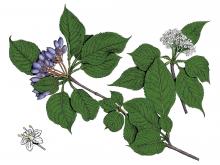Trees, Shrubs and Woody Vines
Media

Species Types
Scientific Name
Lonicera maackii (Amur) and Lonicera x bella (bella)
Description
If there’s a giant green thicket in your woods, you may have a bush honeysuckle infestation. These invasive plants are shrubby natives of Asia. In America, where they have no natural controls, they leaf out early, grow fast, spread fast, and form dense thickets that crowd out native forest plants.
Media

Species Types
Scientific Name
Various species in the genus Crataegus
Description
Our state flower, the hawthorn, is solidly represented in Missouri. There are about 100 different kinds of hawthorns that occupy almost every kind of soil in every part of the state. These members of the rose family are closely related to apples.
Media

Species Types
Scientific Name
Lindera melissifolia
Description
Pondberry is a colony-forming shrub that grows in swampy depressions in lowland forests. It is an Endangered species. In Missouri, only one population occurs, in southern Ripley County.
Media

Species Types
Scientific Name
Ilex decidua
Description
Possum haw, or deciduous holly, is the more common of two native Missouri hollies that lose their leaves each fall. This shrub or small tree is eye-catching in the fall and winter with its bright red berries.
Media

Species Types
Scientific Name
Asimina triloba
Description
“Way down yonder in the pawpaw patch” is an old song you might be familiar with — but today, surprisingly few Missourians know a pawpaw tree when they see one. This is a good tree to know, especially when the large, sweet fruit are ripening!
Media

Species Types
Scientific Name
Cornus spp.
Description
Missouri’s five species of dogwoods are shrubs or small trees with distinctive flowers, fruits, and bark. The fruits may be red, white, or blue. The leaves have characteristic arching veins.
Media

Species Types
Scientific Name
Cornus foemina
Description
Gray dogwood is a deciduous, thicket-forming shrub. Its small, creamy-white flowers occur in branched clusters, and its white or pale blue fruits are supported by red stalks — a characteristic that makes it attractive for ornamental uses.
Media

Species Types
Scientific Name
Cornus drummondii
Description
Rough-leaved dogwood is one of Missouri's hardiest shrubs, capable of withstanding cold and drought. The leaves of this thicket-forming species emit a faint odor of sour milk.
Media

Species Types
Scientific Name
Viburnum lentago
Description
Nannyberry is an understory shrub or small tree that grows in low woods, wooded slopes, and rich valleys near streams. It is officially a Species of Conservation Concern in our state, but its rarity here may be because Missouri is at the southern end of its range.
Media

Species Types
Scientific Name
Vaccinium arboreum
Description
Farkleberry, or sparkleberry, is a stiff-branched shrub or small crooked tree growing in loose thickets on rocky soils, mostly south of the Missouri River. A type of blueberry, its black fruits are edible but dry and mealy.
See Also
About Trees, Shrubs and Woody Vines in Missouri
There are no sharp dividing lines between trees, shrubs, and woody vines, or even between woody and nonwoody plants. “Wood” is a type of tissue made of cellulose and lignin that many plants develop as they mature — whether they are “woody” or not. Trees are woody plants over 13 feet tall with a single trunk. Shrubs are less than 13 feet tall, with multiple stems. Vines require support or else sprawl over the ground.





















